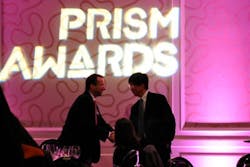San Francisco, CA--Winners of the 2011 Prism Awards for Photonics Innovation were announced at a gala banquet on January 25 during SPIE Photonics West. Nine photonic products in nine different categories—including biophotonics, scientific lasers, and other light sources—garnered awards for their ability to challenge conventional ideas, solve problems, and improve life through the generation and harnessing of light.
Winners and categories are:
89 North (Burlington, VT; Life Sciences and Biophotonics) for the Heliophor, a pumped-phosphor light engine for quantitative fluorescence microscopy that provides an alternative to arc lamps, metal halides, and LED light sources. With nine available wavelength modules, each system is user-configurable. Features include rapid switch times, digital shuttering, and advanced triggering and control capabilities to rapidly interface with other system components and enable high-speed, multidimensional imaging.
PD-LD (Pennington, NJ; Scientific Lasers) for LabSource, a VBG-stabilized, dual-laser source for use in shifted excitation Raman difference spectroscopy (SERDS). LabSource is based on the VBG-stabilized laser diodes with strictly controlled wavelength separation corresponding to the line width of the Raman bands. LabSource allows subtraction of the fluorescence contribution from the Raman signal and is intended for bench-top applications, where its SERDS capabilities can be integrated with existing laboratory analytical equipment.
Amplitude Systèmes (Pessac, France; Industrial Lasers) for the Satsuma HE, an ultrafast fiber laser for industrial markets such as eye surgery, medical device manufacturing, and semiconductor processing. The laser delivers ultra-short pulse duration (350 fs), high repetition rate (1 MHz or more), and high energy (up to 20 µJ) in a compact housing.
MERMEC (Monopoli Bari, Italy; Detectors, Sensing, Imaging and Cameras), for T-Sight 5000, a system mounted to the front of high-speed trains that performs an in-depth inspection and analysis of tunnels and clearance profiles on railways, capturing image data of bridges, underpasses, poles, and other obstacles that may hinder the safe transport of rail passengers and cargo. Once image data are captured, the system can visually recreate 3D images of the railway infrastructure. The system's internal architecture integrates two different systems (clearance gauge measurement and tunnel wall inspection) sharing the same laser illuminating source.
Optotune (Dietikon, Switzerland; Optics and Optical Components) for the Laser Speckle Reducer (LSR), which enables speckle reduction in laser-based picoprojectors. While a traditional approach is to use rotating diffusers, the LSR uses electroactive polymers to oscillate a diffuser. Laser speckle is one of the biggest roadblocks that prevents lasers from becoming the standard for projection light sources. The grainy pattern of spots reduces the resolution and quality of projected images.
Physical Optics Corporation (Torrance, CA; Defense and Security) for its Mobile ELISA-based Pathogen Detection (MEPAD), a portable, USB-powered biohazard detection system. The system is based on a disposable microfluidic chip for multiple-threat detection and a highly sensitive portable microfluidic fluorescence measurement unit that also controls the flow of samples and reagents through the microfluidic channels of the chip. This innovative product addresses the need for real-time biohazard identification for first responders in the field and point-of-care specialists with a cost-efficient and automated implementation of ELISA-based process that currently requires analytical expertise and laboratory processing. The sample processing is fully contained within a chip with minimal risk of contamination. All processing steps are fully automated and controlled by a computer.
nanoplus (Gerbrunn, Germany; Green Photonics and Sustainable Energy) for its DFB laser at 3 µm, which operates in more than 10,000 installations (including gas pipelines, power plants, airborne, and satellite applications) worldwide. Tunable diode laser spectroscopy (TDLS) detects molecular constituents in gas phase, enabling detection of CO, CO2, H2O, O2, NH3, SO2, and others in the 3 to 3.5 µm region.
WITec (Ulm, Germany; Test, Measurement, Metrology) for its True Surface Microscopy, which allows measurement of rough or inclined samples while maintaining the advantages of confocal imaging. True Surface Microscopy features an integrated sensor for optical profilometry, enabling rough or inclined samples to stay in focus while performing confocal (Raman) imaging. Large-area topographic coordinates from the profilometer measurement can be precisely correlated with the large-area confocal Raman imaging data.
OEWaves (Pasadena, CA; Other Light Sources) for the Ultra-Narrow Linewidth Laser, a semiconductor laser based on a high quality factor (Q) whispering gallery mode (WGM) micro-resonator that offers super-fine instantaneous and dynamic optical spectral linewidth of <300 Hz and ultra-low phase/frequency noise in a small form factor. The laser is scalable to a variety of wavelengths in the C and L bands. Its monolithically integrated approach along with micro-scale mass and volume make the laser virtually insensitive to environmental vibrations. A panel of independent industry and academic experts judged nearly 100 entries, selecting the winners from among 28 finalists.
Presenting the Prism awards was Tim Day (Daylight Solutions), Wellington Chadehumbe (Triumph Venture Capital), Michael Lebby (Translucent), Laura Smoliar (Peppertree Engineering), Mary Lou Jepsen (Pixel Qi), Mike Cumbo (IDEX), Rob Randelman (Halma), and Larry Marshall (Southern Cross Venture Partners).
